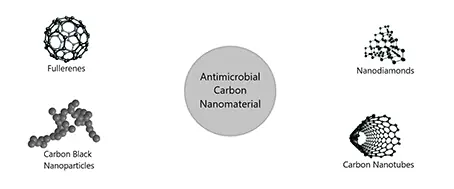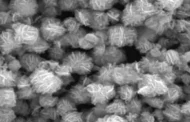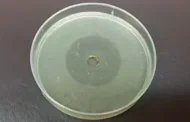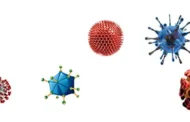NanoMicrobiol NanoBiotechnol, 2023 (2), 202321
DOI:
Review
Non-metal anti-bacterial nanoparticles
Erfan Haghighat-Seir 1*
1 Department of Medical Biotechnology, Gerash University of Medical Sciences, Gerash, Iran
* Correspondence: erfanhaghighat.eh@gmail.com
Abstract
With increasing of resistance of Bacteria to antibiotics there is need for substitutes with better or equal bactericide effect. In this vein, nanoparticles could play a vital role because of their cheap manufacturing cost and high antimicrobial activity. In the past some metals and minerals have been known to exhibit antibacterial effect and have been used for this characteristics, without knowledge of how this effect takes place. Forward to today, and we are still using metal nanoparticles for fighting against various types of infections only now we know the mechanism of action that metal nanoparticles use to kill bacteria. But one question is left unsolved and that is the possible toxic effect of metal nanoparticles on host organism. Non-metal antibacterial nanoparticles could be the answer for that since they are more biocompatible meaning that they are less toxic to the host organism, and more biodegradable meaning that they break down more easily in host organism. Non-metal nanoparticles that have stablished antimicrobial efficacy are mostly made out of carbon and sulfur or other chemically synthesized organic nanoparticles. Other non-metal nanoparticles that are mentioned in this work are calcium and silica based nanoparticles which have very little antimicrobial effect on their own but are mostly used for deliverance of other drugs. Nanoparticles are very good for drug delivery because of their high tissue and biofilm penetrance which could be taken advantage of. In this paper a summary of what so far has been accomplished for Non-metal Anti-Bacterial Nanoparticles has been put together.
Keywords: Calcium nanoparticles; Carbon nanoparticles; Organic nanoparticles; Silica nanoparticles; Sulfur nanoparticles
1 Introduction
With increasing of resistance of Bacteria to antibiotics, Nanomaterials (NMs) are gaining great importance because they are used as antibacterial complementary to antibiotics. An antibacterial drug is used in medication for treatment of bacterial infections. It is of great interest to formulate new antimicrobial agents from natural sources, which are cost-effective and resistance-free They may be metal or non-metal having different properties. Firstly, they have a large surface area, which increases contact with target organisms. NPs can interact with bacterial cells, disturb the bacterial cell wall, or interfere with indifferent molecular paths. Secondly, inhibitory effects of antibiotics are increased by them. Saha et al. (2007) showed that a combination of gold nanoparticles with kanamycin, streptomycin, or ampicillin can reduce the minimum inhibitory concentration of the antibiotic in contradiction of gram-positive and gram-negative bacteria (1). The mutual effect of antibiotics and NPs provide great antimicrobial properties, as seen in a study done in 2011 (2). Non-metallic nanoscale materials, i.e., carbon nanoparticles (CNPs), sulfur nanoparticles, silica nanoparticles, and nitric oxide nanoparticles, have been considered as innovative antimicrobial agents having good physiochemical characteristics.
2 Synthesis of Nanoparticles
Top-down and bottom-up are two methods for synthesizing metallic non-metallic nanoparticles. The top-down method involves breaking large structures into small structures. Lithography, laser ablation, sputtering deposition, pulsed electrochemical etching, and vapor deposition vapor are techniques generally used in the top-down method. The top-down method is mostly used for preparation of non-organic nanoparticles. The bottom-up method consists of manufacturing material molecule by molecule, atom by atom, or cluster by cluster using the processes of sol-gel, laser heating transformation, chemical vapor deposition, plasma spray synthesis, and micro emulsion (3).
Green synthesis is one of the better ways for bottom-up manufacturing of nanoparticles. Some advantages of green synthesis are cost-effectiveness, low contamination risk, safe and environment-friendly, low waste production, and biomedical and pharmaceutical usability. In this method of synthesis, microorganisms and organic materials produced by microorganisms could be used. Carbohydrates are the prime organic material used in synthesis of NPs because of their reducing capabilities. Green synthesis can be done through honey usage. Honey-mediated synthesis is a fast method having an advantage over the microbial method due to microorganism culturing and separation of nanoparticles from microorganisms (4).
Chemical vapor deposition (CVD) involves deposition of gas phased materials which are to become nanoparticles, as a thin film on the substrate through reaction compartments. A chemical reaction occurs when gas interacts with intense substrate resulting in formation of nanoparticles. This film is improved and recycled for further usage. Advantages of this vapor deposition method are purified, hardened, strengthened, and uniform nanoparticles. CVD has some disadvantages, including its requirement of a special equipment and the release of toxic gases as byproducts, making this method a dangerous one for environment and technicians (5).
3 Mechanism of antibacterial activity of nanomaterials
Nanomaterials behave in two lethal ways: (1) membrane disruption and (2) production of ROS. When nanomaterials statically bind to bacterial cell walls and cell membranes, destruction happens, which changes the membrane working capacity and decreases its stiffness, which can cause transport unbalancing, respirational problems, energy disruption, and cell lysis, leading to cell death (6). ROS is involved in both in vivo and in vitro cytotoxicity of nanomaterials. The high concentrations of ROS cause stress, protein structural changes, enzyme inhibition, nucleic acid damage, and even cell lysis (6).
4 Carbon nanoparticles
Carbon possess low cytotoxicity and have particular antiviral properties. In microorganisms, damage to the cell wall and cell membrane is due to carbon nanostructures (CNSs), i.e., graphene sheets cause cell death (7). Toxic substances, i.e., ROS, may generate due to chemical connection between CNSs and the microorganism that is the cause of oxidative stress. The electron transferring process occurs due to interactions in which electrons from the outer surface of microbes are devastated, which causes cell death (8).
Fullerenes are made up of nanomaterials in a hollow cage structure with diameter of 0.71 nm. They may be carbon 60 or carbon 70 in pentagonal and hexagonal shape. They have great importance due to their structure, strength, versatility, electrical conductivity, and electron affinity. In microorganisms, they cause disruption of cell membranes and DNA breakage. By manipulating their energy uptake, microorganisms are deactivated (9).
Carbon nanotubes (CNTs) are long tubular structures with diameters of 1–2 nm. They act as semiconductors. Their structure is just like a rolled-up graphite sheet. CNTs have a honeycomb carbon frame structure, which is twisted into a hollow cylinder. They can be bent, but regain their strong structure. They have different structures, shapes, and thickness levels. The properties of CNTs are based on sheets of graphene. CNTs show an antibacterial property by membrane integrity disturbance due to electrostatic forces between CNTs and the microbial outer surface, which cause deterioration of the membrane. Production of reactive oxygen damages biological molecules of bacteria and incidentally damage deoxyribonucleic acid.
Graphene-related materials have antibacterial mechanisms such as damage of cell membrane, harmful removal of phospholipids from lipid membranes, reactive oxygen species causing oxidative stress, and microorganism separation from their microenvironment (3).
Carbon black is an amorphous carbon that shows antibacterial characteristics by incorporating into the bacterial cell. It has a spherical shape with diameter of 20 to 70 nm. It is in aggregate form, meaning that it lacks any specific geometrical shape. The size of the carbon particles is inversely proportional to the antimicrobial activity. Carbon black shows a large surface area and huge quantity of atoms present within the surface and near to the layers of surface (10).
Nanodiamonds are an important class of carbon nanomaterials. These nanoparticles have a rigid carbon core which reduces degradation while having reactive groups like ─COOH ─OH, and ─NH2 on its surface which facilitates loading of other bioactive compounds and helps with solubility of the Nanodiomands. This highly reactive surface of NPs gives them their unique antibacterial properties. Nanodiomands of smaller size (~5nm) possess lysis properties in both Gram-negative and Gram-positive bacteria. The mechanism of action that leads to death of bacteria differs greatly from that of the lysosome, making Nanodiomands a better way to deal with bacteria that possess some resistance to lysosome enzyme. For example, these NPs have been used in clinical dentistry in order to battle infections (3).
5 Sulfur nanoparticles
Sulfur is a biologically active element that is easily available and helpful in dermatological treatment, for example, in acne ointments and dandruff shampoos. Sulfur also has antifungal properties that can help restore local microbiome. The exact antibacterial mechanism of sulfur nanoparticles is poor, but they produce toxic H2S gas that reacts with thiol present in proteins and lipids, and as a result interferes with DNA, denatures it, and ultimately causes the death of cells. High hydrophobicity of sulfur nanoparticles has limited the actual use of sulfur which makes Surface modified nano-sized sulfur nanoparticles (SNPs) to have excellent antimicrobial and antifungal activities and used for the production of anticancer and antibacterial agents. Acidification of sodium thiosulfate and stabilization of SNPs with surfactants or capping agent is one way to coat the surface of Sulfur nanoparticles for better solubility and functionality (11).
6 Silica nanoparticles
Silica nanoparticles that do not possess inherent antimicrobial activity have been modified to produce microbicidal nanomaterials. Silica nanoparticles are mostly used for drug delivery, meaning that its antimicrobial property is its low reactivity that helps it to be a safe particle for host organism. There are many different types of Silica nanoparticles (SiNPs), such as the conventional non-porous SiNPs, mesoporous silica nanoparticles (MSN), hollow mesoporous silica nanoparticles (HMSN) and core-shell silica. For example, hollow mesoporous silica nanoparticles are used in drug delivery due to their stress-free function and drug loading capacity, and have been used as adjuvant in vaccine preparation. Also Silica nanoparticles are reported to eliminate microbial biofilms by releasing nitric oxide (NO), which is a reactive nitrogen species (RNS) in vitro.
Synthesized Silica nanoparticles are mostly between 10 and 500 nm and have long rod, short rod and spherical shape. Long rod has the longest blood circulation time due to its larger mass making it more suitable for drug delivery. And out of all three of the conventional shapes of SiNPs that is mentioned above short rods have the fastest degradation time due to their larger surface area.
Since SiNPs are mostly used for drug delivery, some are designed to have pores in order to load the drug. While small pore size results in harder loading and has the lowest loading capacity, it has the advantage of longer release time compared to larger pore size which could result in premature drug release leading to toxicity and other side effects.
The surface of SiNPs have silanol groups (Si-OH) which acts as a good base for attachment of other molecules which are either co-condensated in manufacturing of SiNP or added in post-synthetic grafting. The post-synthetic grafting involves conjugation of functional groups, mostly on the surface of the nanoparticle, whereas the co-condensation approach puts the functional groups even inside the pores of the nanoparticles. Post-synthetic grafting results in higher stability of the nanoparticle core. Polyethylene glycol (PEG) is often used as modifying agent as it can improve stability of SiNPs, and provide higher blood circulation time and better biocompatibility. Hydrophilic polymer, such as PEG, forms a protective layer around the nanoparticles that protects the core from deteriorating (3, 12).
7 Calcium-Based Nanoparticles
Ceramic based nanoparticles have little to no bioactivity and antimicrobial properties. So these nanoparticles have to be modified in order for them to have microbicidal activity. There are three ways to modify calcium-based NPs: first, antimicrobial compounds could be chemically attached on the surface of these NPs. For example, NPs could be loaded with compounds that have Nitric Oxide releasing properties. Second, in the fusion of metals with antimicrobial properties like Cupper, Zink or Silver to NPs. The third method involves antibiotics attachment or loading in these NPs (3).
8 Nitric-Oxide-Releasing Nanoparticles
Nitric Oxide is a natural occurring chemical that is produced by organisms and could be used as an antibacterial agent because of low levels of resistance in bacteria. This compound works by producing reactive Nitrogen species (RNS) and reactive Oxygen species (ROS). Nitric Oxide association with tissue healing and helping innate immune response in more advance organisms, making this method of a better fit as in vivo bactericide. To avoid premature releasing or production of NO, encapsulation methods have been established for a better control release. Loading of NO releasing compounds on nanoparticles that already possess antibacterial properties could increase its potency, achieve a longer release time and avoid cytotoxicity. Sodium nitroprusside has also been used as a NO releasing compound in polymeric or inorganic nanostructures (3).
9 Organic Nanoparticles
Polyethylenimine Nanoparticles adjacent with quaternary ammonium groups exhibits antimicrobial activity by disrupting of the bacterial cell membrane. Making them a better suit for fighting infections caused by mycobacteria or other bacteria not having cell wall.
Chitosan is the deacetylated chitin, the second most plentiful naturally occurring biopolymer which is the main component of insect’s exoskeleton. Chitosan possesses no bioactivity, making these NPs to be a biocompatible and biodegradable carriers suitable for delivery of NO releasing compounds, metal based nanostructures and antibiotics.
Conductive Polymer-Based Nanoparticles are polymers that contain ─NH─ and ─S groups in their chains, making them to have protonation–deprotonation cycles that induce positive or neutral centers in their main chains that gives them their antimicrobial character. In addition, electrostatic attachment between polymeric nanoparticles and bacterial cell wall molecules results in lysis of the bacteria (3).
10 Non-Metal Nanoparticles as carriers
Most previous studies on antimicrobial activity of nanoparticles have been done on metal nanoparticles since metal toxicity is of a much more danger to organisms than toxicity caused by non-metal atoms. This property of less toxicity has led to usage of non-metal nanoparticles as more of a carrier system.
Nanoparticles are good vectors such as Mesoporous Silica Nanoparticles (MSNs) to carry genes, medicine, proteins, and DNA because of their easy production process, biocompatibility, and stability (13). Additionally, MSNs can easily control the release of drugs due to their size modification. Also Hollow mesoporous silica nanoparticles have extraordinary drug loading capacity.
Carbon-based nanodelivery systems are intricate, non-degradable, less toxic, and intrinsically non-immunogenic and have importance as antigen carriers. Macrophages, monocytes, natural killer cells, dendritic cells, and T and B cells can be linked with Carbon Nanotubes (CNTs) and these immune cells have a higher uptake of CNTs. CNTs are harmless to the cells function. Toxicity of functionalized CNTs is lower than original CNTs. CNTs can trigger innate immune cells (14).
Non-metal nanoparticles could also be used as a core for metal atoms making metal-modified nanoparticles. In this regard, copper and silver infused silica nanoparticles are of high importance. Most of biological activity of Silver is achieved by its link with thiol groups present in enzymes. Silver coating spherical nanoparticles were easily made by tetraethoxysilane and silver nitrate with ascorbic acid. Silver nanoparticles were bound on magnetic silica composite surface for preparation of magnetic disinfectant having stability and antibacterial activity. Silver nanoparticles having diameter of 10 nm were fixed then firmly bound on Si coating of Fe3O4–SiO2 magnetic NPs to avoid silver aggregation (15).
Copper has importance due to antibacterial action, which was examined by the disk
diffusion method. It can change protein and enzyme construction so its function can vary, which results in bacterial inactivation. Copper can be added on the surface such as SiNPs, but the release of Cu can be hindered (16).
11 Antibiotics and non-metal nanoparticles
Attachment of antibiotics with nanoparticles is of great importance because it protects the drug to the target tissue. High concentrations of antibiotics reach the targeted cells while reducing the dosage quantity, resistance to antibiotics, and side effects (17). Silica nanoparticles are used in drug delivery due to thermal stability and large surface area (12).
Non-metal nanoparticles have been documented to be able to lower the resistance of bacteria. So non-metal nanoparticles could be used alongside antibiotics. Even though nanoparticle and antibiotics are not connected they could enhance antibacterial effect of each other.
12 Challenges of using non-metal antimicrobial nanoparticles
there are disadvantages of using nanoparticles as antimicrobial agents such as production problems, economic issues, and negative health impacts. The standard method of dosage of nanoparticles administration in different organs needs to be developed. Administration of nanoantibiotics may cause multiorgan nanotoxicity (17). Nanoparticles and their degraded products can obstruct the coagulation pathways by implicating the hemolysis. Non-metal nanoparticles like fullerenes and nanotubes may cause toxicity if not administered at the desired concentration (18). NPs when administered through the IV route may cause direct damage to the spleen, lung, liver, and bone marrow. Similarly, due to their small size and more cell vitality, NPs may cause damage to the brain, heart, lung, and liver when inhaled. More studies on stability, dispersion, biodistribution, final product, and possible side effects of nanoparticles need to be carried out before putting them in the clinical trials on animal models (19). Another challenge is minimizing the cost. Conventional antimicrobials are advantageous due to cost-effectiveness. SWNTs and MWNTs are more expensive than conventional antimicrobials. So, nanomaterial usage is significant because nanomaterials synthesize CNTs at low prices (20).
Conclusion
Indiscriminate use of antibiotics is causing serious problems in the medical field like multidrug resistance, and due to drug residues, new diseases are emerging, so it becomes difficult to treat many diseases. To overcome these problems, non-metal nanoparticles have been shown to exhibit antimicrobial activity. A combination of antibiotics with nanoparticles is of great importance because it protects drug to the target tissue. Nanovaccines are also effective because nanoparticle linkage with antigens produce strong immune response as compared to antigens alone. In the medical field, this approach has been trending. However, less information is available about their toxicity and harmful effects, nevertheless they have been getting more attention toward resolving problems in the field of medicine. Organic antimicrobial agents act faster than inorganic agents, making their nanoparticles a better fit for killing bacteria and reducing infection. Also inorganic agents can be coupled with organic nanoparticles for better biocompatibility and less toxicity. Organic nanoparticles are biodegradable making them a better fit for drug deliveries and antibacterial therapy in advanced organisms, in medical and veterinary practices. Organic nanoparticles have their own disadvantages too. Polymeric organic NPs are less stable than inorganic ones. They are also less cost effective. Therefore, more research into production procedures need to be done in order to make them a more economical approach for large scale antibacterial therapies.
References
-
- Saha B, Bhattacharya J, Mukherjee A, Ghosh A, Santra C, Dasgupta AK, et al. In vitro structural and functional evaluation of gold nanoparticles conjugated antibiotics. Nanoscale Research Letters. 2007;2:614-22.
- Huh AJ, Kwon YJ. “Nanoantibiotics”: a new paradigm for treating infectious diseases using nanomaterials in the antibiotics resistant era. Journal of controlled release. 2011;156(2):128-45.
- Wang Cy, Makvandi P, Zare EN, Tay FR, Niu Ln. Advances in antimicrobial organic and inorganic nanocompounds in biomedicine. Advanced Therapeutics. 2020;3(8):2000024.
- Balasooriya ER, Jayasinghe CD, Jayawardena UA, Ruwanthika RWD, Mendis de Silva R, Udagama PV. Honey mediated green synthesis of nanoparticles: new era of safe nanotechnology. Journal of Nanomaterials. 2017;2017.
- Bhaviripudi S, Mile E, Steiner SA, Zare AT, Dresselhaus MS, Belcher AM, et al. CVD synthesis of single-walled carbon nanotubes from gold nanoparticle catalysts. Journal of the American Chemical Society. 2007;129(6):1516-7.
- Wang L, Hu C, Shao L. The antimicrobial activity of nanoparticles: present situation and prospects for the future. International journal of nanomedicine. 2017;12:1227.
- Prasad K, Lekshmi G, Ostrikov K, Lussini V, Blinco J, Mohandas M, et al. Synergic bactericidal effects of reduced graphene oxide and silver nanoparticles against Gram-positive and Gram-negative bacteria. Scientific reports. 2017;7(1):1591.
- Li J, Wang G, Zhu H, Zhang M, Zheng X, Di Z, et al. Antibacterial activity of large-area monolayer graphene film manipulated by charge transfer. Scientific reports. 2014;4(1):4359.
- Astefanei A, Núñez O, Galceran MT. Characterisation and determination of fullerenes: a critical review. Analytica chimica acta. 2015;882:1-21.
- Dong L, Henderson A, Field C. Antimicrobial activity of single-walled carbon nanotubes suspended in different surfactants. Journal of Nanotechnology. 2012;2012.
- Saedi S, Shokri M, Rhim J-W. Antimicrobial activity of sulfur nanoparticles: effect of preparation methods. Arabian Journal of Chemistry. 2020;13(8):6580-8.
- Selvarajan V, Obuobi S, Ee PLR. Silica nanoparticles—a versatile tool for the treatment of bacterial infections. Frontiers in chemistry. 2020;8:602.
- Xu C, Niu Y, Popat A, Jambhrunkar S, Karmakar S, Yu C. Rod-like mesoporous silica nanoparticles with rough surfaces for enhanced cellular delivery. Journal of Materials Chemistry B. 2013;2(3):253-6.
- Villa CH, Dao T, Ahearn I, Fehrenbacher N, Casey E, Rey DA, et al. Single-walled carbon nanotubes deliver peptide antigen into dendritic cells and enhance IgG responses to tumor-associated antigens. ACS nano. 2011;5(7):5300-11.
- Malekzadeh M, Yeung KL, Halali M, Chang Q. Preparation and antibacterial behaviour of nanostructured Ag@ SiO 2–penicillin with silver nanoplates. New Journal of Chemistry. 2019;43(42):16612-20.
- Michels H, Wilks S, Noyce J, Keevil C. Copper alloys for human infectious disease control. Stainless steel. 2005;77000(55.0):27.0.
- Anwar MA, Aqib AI, Ashfaq K, Deeba F, Khan MK, Khan SR, et al. Antimicrobial resistance modulation of MDR E. coli by antibiotic coated ZnO nanoparticles. Microbial Pathogenesis. 2020;148:104450.
- Saleemi MA, Yong PVC, Wong EH. Investigation of antimicrobial activity and cytotoxicity of synthesized surfactant-modified carbon nanotubes/polyurethane electrospun nanofibers. Nano-Structures & Nano-Objects. 2020;24:100612.
- Manzano M, Vallet‐Regí M. Mesoporous silica nanoparticles for drug delivery. Advanced functional materials. 2020;30(2):1902634.
- Liu D, Mao Y, Ding L. Carbon nanotubes as antimicrobial agents for water disinfection and pathogen control. Journal of Water and Health. 2018;16(2):171-80.






